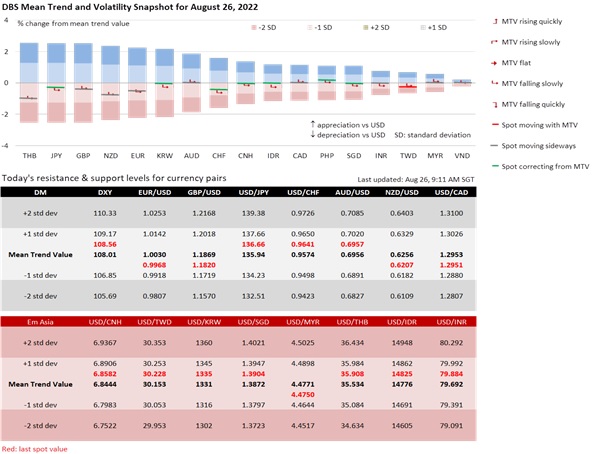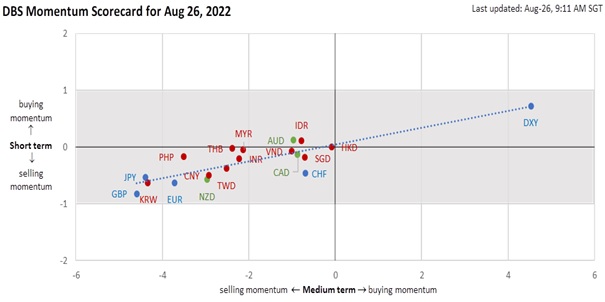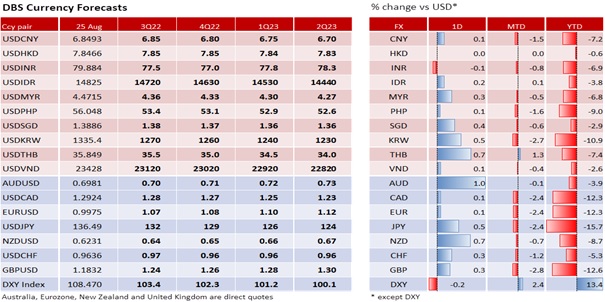Related insights_tr
- Short AUD-CHF on Geopolitical Concerns19 Apr 2024
- Central Banks Hold Steady19 Apr 2024
- AIA Group19 Apr 2024

There were no surprises on the first day of the Kansas City Fed’s Annual Jackson Hole Forum. Fed officials stuck to the script laid out at the July FOMC meeting. Many expect Fed Chair Jerome Powell to do the same today. Better US data lifted the Dow, S&P 500 and Nasdaq Composite by 1%, 1.4% and 1.7% respectively. The US Treasury 10Y yield eased 7.8 bps to 3.026%; 2Y fell 2.5 bps to 3.366%. The futures market expects the Fed Funds Rate to peak at 3.50% this year into 2023. DXY is fluctuating between 108 and 109, at the top of the 105-109 range set in July. We remain mindful that the USD’s surge in March-July stemmed from the Fed Funds Rate catching up to bond yields. As things stand, it defeats the purpose for the Fed to hike by 75 bps next month only to have bond yields below the policy rate.
First, US inflation is too high for Fed to ease off the brakes. Today, Bloomberg consensus expects the US PCE deflator to decline to 6.4% YoY in July from 6.8% in June, and the core deflator to 4.7% from 4.8%. Although CPI inflation eased earlier to 8.5% YoY from 9.1% for the comparable period, Fed President James Bullard (St Louis) was concerned about inflation staying high for longer. Before the forum, Neel Kashkari (Minneapolis) was also worried about inflation becoming persistent.
Second, the Fed wants rates to be restrictive above the estimated 2-3% neutral range this year. Most agree with the Fed’s Summary of Economic Projections for rates to end around 3.4% this year and 3.8% next year. Hawks like Bullard wants to frontload hikes to 3.75-4% this year. Esther George (Kansas City) wants rates to keep rising until there is evidence that inflation is falling. She did not rule out a terminal rate above 4%. On 23 August, Kashkari signalled rates could rise another 200 bps above the present 2.5% by the end of 2023 to anchor inflation expectations. Patrick Harker (Philadelphia) reckoned rates could rise above 3.4% before the Fed pauses to assess the impact of the hikes.
Third, the Fed could hike by 50 bps or 75 bps on 21 September, depending on the incoming US data. Harker considered 50 bps a substantial move. Markets will pay close attention to two sets of data. The first will be the US monthly jobs report on 2 September. Consensus expects nonfarm payrolls to slow to 300k in August after the surprise jump to 528k in July. US initial jobless claims fell more-than-expected to 243k (vs 252k consensus) for the 20 August week from 245k (revised from 250k) the previous week. The decline in continuing claims to 1415k from 1434k suggests that the unemployment rate will stay low at 3.5%. The second will be the US CPI data on 13 September, the key data that preceded the past two 75 bps hikes.
Fourth, the Fed hopes to achieve a soft landing while controlling inflation. Yesterday, the Bureau of Economic Analysis revised 2Q22 GDP growth to an annualized -0.6% QoQ saar from its advance estimate of -0.9%. Harker did not see a high risk of a sustained deep recession. Interestingly, Bullard did not have a clear outlook for 2023, acknowledging that recession risks accompany the frontloading rate hikes. On 19 August, Thomas Barkin (Richmond) also admitted a recession could happen to get inflation under control.
Quote of the day
“There is a safe spot within every tornado. My job is to find it.”
David Copperfield
26 August in history
Harry Houdini escaped from chains underwater in 57 seconds, at Aquatic Park in San Francisco, California in 1907.




Subscribe here to receive our economics & macro strategy materials.
To unsubscribe, please click here.
Topic
The information herein is published by DBS Bank Ltd and/or DBS Bank (Hong Kong) Limited (each and/or collectively, the “Company”). This report is intended for “Accredited Investors” and “Institutional Investors” (defined under the Financial Advisers Act and Securities and Futures Act of Singapore, and their subsidiary legislation), as well as “Professional Investors” (defined under the Securities and Futures Ordinance of Hong Kong) only. It is based on information obtained from sources believed to be reliable, but the Company does not make any representation or warranty, express or implied, as to its accuracy, completeness, timeliness or correctness for any particular purpose. Opinions expressed are subject to change without notice. This research is prepared for general circulation. Any recommendation contained herein does not have regard to the specific investment objectives, financial situation and the particular needs of any specific addressee. The information herein is published for the information of addressees only and is not to be taken in substitution for the exercise of judgement by addressees, who should obtain separate legal or financial advice. The Company, or any of its related companies or any individuals connected with the group accepts no liability for any direct, special, indirect, consequential, incidental damages or any other loss or damages of any kind arising from any use of the information herein (including any error, omission or misstatement herein, negligent or otherwise) or further communication thereof, even if the Company or any other person has been advised of the possibility thereof. The information herein is not to be construed as an offer or a solicitation of an offer to buy or sell any securities, futures, options or other financial instruments or to provide any investment advice or services. The Company and its associates, their directors, officers and/or employees may have positions or other interests in, and may effect transactions in securities mentioned herein and may also perform or seek to perform broking, investment banking and other banking or financial services for these companies. The information herein is not directed to, or intended for distribution to or use by, any person or entity that is a citizen or resident of or located in any locality, state, country, or other jurisdiction (including but not limited to citizens or residents of the United States of America) where such distribution, publication, availability or use would be contrary to law or regulation. The information is not an offer to sell or the solicitation of an offer to buy any security in any jurisdiction (including but not limited to the United States of America) where such an offer or solicitation would be contrary to law or regulation.
This report is distributed in Singapore by DBS Bank Ltd (Company Regn. No. 196800306E) which is Exempt Financial Advisers as defined in the Financial Advisers Act and regulated by the Monetary Authority of Singapore. DBS Bank Ltd may distribute reports produced by its respective foreign entities, affiliates or other foreign research houses pursuant to an arrangement under Regulation 32C of the Financial Advisers Regulations. Singapore recipients should contact DBS Bank Ltd at 65-6878-8888 for matters arising from, or in connection with the report.
DBS Bank Ltd., 12 Marina Boulevard, Marina Bay Financial Centre Tower 3, Singapore 018982. Tel: 65-6878-8888. Company Registration No. 196800306E.
DBS Bank Ltd., Hong Kong Branch, a company incorporated in Singapore with limited liability. 18th Floor, The Center, 99 Queen’s Road Central, Central, Hong Kong SAR.
DBS Bank (Hong Kong) Limited, a company incorporated in Hong Kong with limited liability. 13th Floor One Island East, 18 Westlands Road, Quarry Bay, Hong Kong SAR
Virtual currencies are highly speculative digital "virtual commodities", and are not currencies. It is not a financial product approved by the Taiwan Financial Supervisory Commission, and the safeguards of the existing investor protection regime does not apply. The prices of virtual currencies may fluctuate greatly, and the investment risk is high. Before engaging in such transactions, the investor should carefully assess the risks, and seek its own independent advice.
Related insights_tr
- Short AUD-CHF on Geopolitical Concerns19 Apr 2024
- Central Banks Hold Steady19 Apr 2024
- AIA Group19 Apr 2024
Related insights_tr
- Short AUD-CHF on Geopolitical Concerns19 Apr 2024
- Central Banks Hold Steady19 Apr 2024
- AIA Group19 Apr 2024


